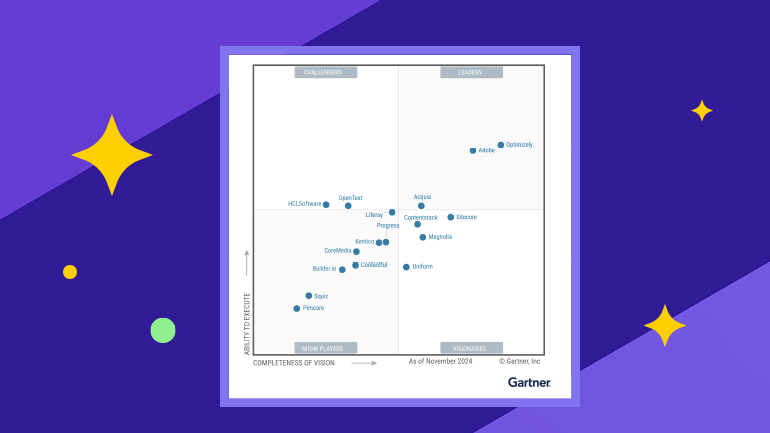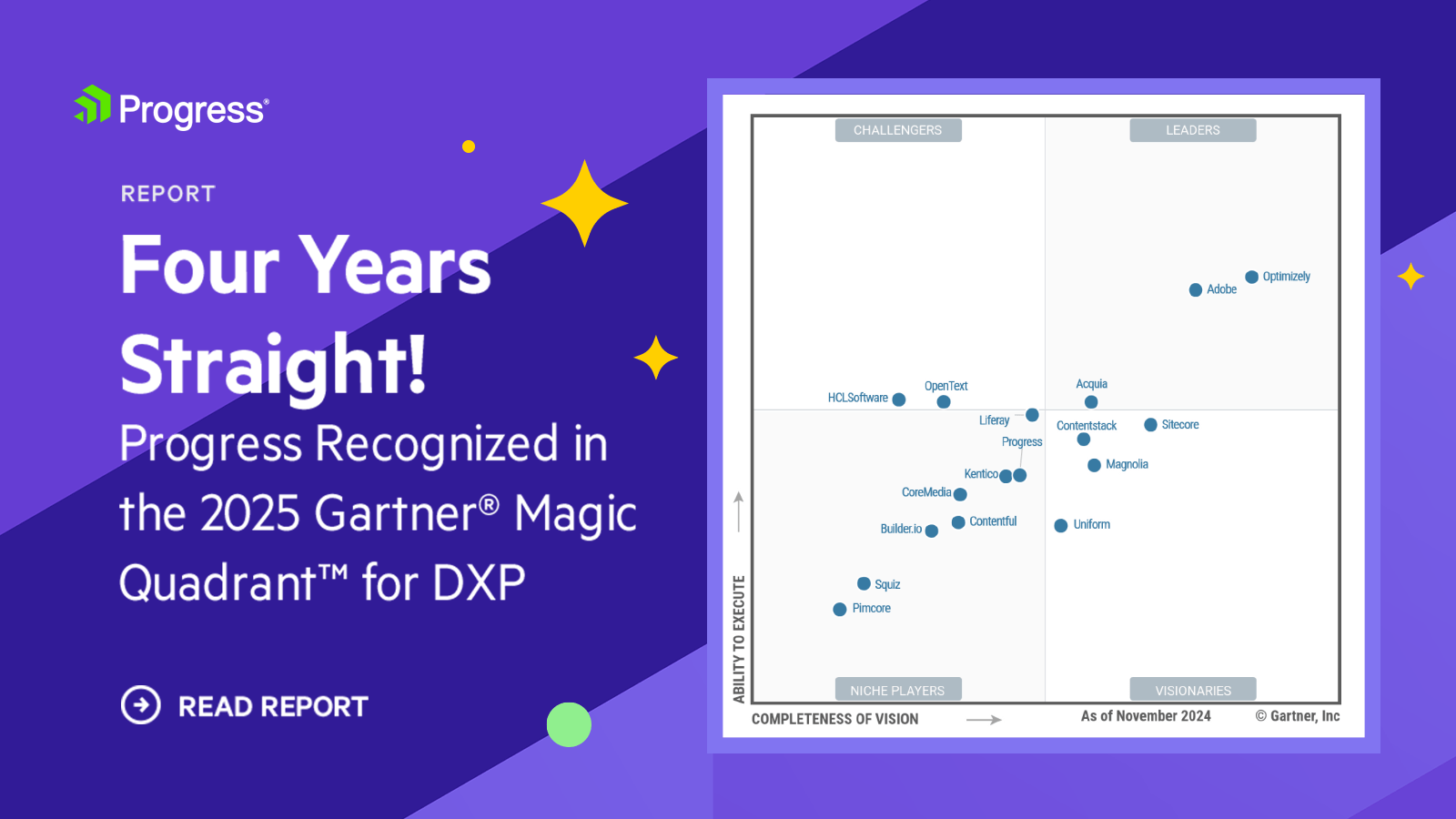Progress Recognized in the 2025 Gartner® Magic Quadrant™ for Digital Experience Platforms

For the fourth consecutive year, Progress has been recognized in the Gartner Magic Quadrant for Digital Experience Platforms (DXP).
We have achieved significant milestones throughout the past year that highlight our commitment to excellence and innovation in the digital experience space.
Throughout the past year, Progress reached several milestones that we believe have influenced our 2025 Gartner MQ for DXP position, including:
- Native Support for Next.js: Build high-performance digital experiences with the leading React framework
- AI-Powered Low-Code Workflows: Optimize content creation with Generative AI
- Advanced AI-Driven Journey Mapping: Enhance ROI and marketing productivity with AI-powered propensity scoring and journey optimization tools
- Certified CDP Excellence: Progress® Sitefinity Insight® recognized as a top customer data platform by the CDP Institute.
Where Can I Download the 2025 Gartner Magic Quadrant for Digital Experience Platforms?
You can download your complimentary copy of the report evaluating 17 leading DXP vendors here: Download report.
What Is the Gartner Magic Quadrant for Digital Experience Platforms?
The Magic Quadrant is a market research report offering “visual snapshots, in-depth analyses and actionable advice that provide insight into a market’s direction, maturity and participants.
“Magic Quadrants compare vendors based on Gartner’s standard criteria and methodology. Each report comes with a Magic Quadrant graphic that depicts a market using a two-dimensional matrix that evaluates vendors based on their Completeness of Vision and Ability to Execute.”
For the 2025 report, Gartner analyzed and positioned 17 vendors across different categories, such as content management, cloud capabilities, composable architecture, support for multiexperience presentation and many more.
What Is a DXP?
Gartner defines a DXP as “an integrated set of technologies designed for the composition, management, delivery and optimization of personalized digital experiences across multiple channels in the customer journey.”
How to Use the Gartner Magic Quadrant for Digital Experience Platforms?
To effectively use the Gartner Magic Quadrant for Digital Experience Platforms (DXP), focus on its two critical criteria: ability to execute and completeness of vision.
- "Ability to execute" assesses a vendor's success in delivering solutions, operational performance and customer satisfaction
- "Completeness of vision" evaluates vendor’s insight into market trends and innovation.
Referring to the Gartner Magic Quadrant for Digital Experience Platforms as a starting point can help you build internal use cases, support vendor evaluations, inform your strategy for replatforming to a new technology or upgrade fragmented web presences (e.g., multiple standalone CMSs).
Key consideration when evaluating a DXP vendor
- A modern DXP should offer composability, multiple deployment options (on-prem, cloud) and meet the needs of three key personas: developers (seeking specific tech stack support, customization and quick deployment), marketers (focusing on tools for content, customer data integration and campaigns) and business stakeholders (interested in TCO, ROI and investment efficiency).
- Consider whether a vendor can support your specific use cases, has a proven track record and offers a pool of satisfied customers in your vertical who have successfully launched projects on time and within budget. Avoid the common pitfall of relying solely on a vendor’s placement or brand reputation. Instead, assess their ability to align with your unique needs and strategic goals. This broader evaluation delivers the best value and long-term results for your organization.
- Evaluators should also review previous Gartner reports to identify trends and major shifts in vendor positioning over the years. Tracking these changes provides valuable insights into how vendors have evolved, whether they have improved execution, expanded their vision or faced challenges that impacted their placement. This historical perspective helps in making a more informed decision beyond just the latest Magic Quadrant.
In addition to the Gartner Magic Quadrant for Digital Experience Platforms as a valuable starting point, organizations should evaluate vendors against additional criteria. Review these helpful resources to expand your CMS and DXP evaluation criteria:
- The Vendor Selection Guide offers an overview of key capabilities that have become mandatory, helping organizations broaden their evaluation framework.
- Submitting an RFP is a strategic way to define requirements and collaborate with vendors to identify the right solution, including capabilities, deployment model, support plans and an implementation blueprint. It provides clarity, can prevent overinvestment and helps avoid launch delays, achieving alignment with your organization's goals and timelines.
- Define internal requirements: Evaluate internal resources to decide whether you need a developer-first, or a Marketing-friendly CMS and which deployment models (on-premises, PaaS or SaaS best match your organizational needs.
- Explore Peer Reviews: Evaluators should check Gartner Peer Insights for in-depth, enterprise-grade reviews and G2 for customer ratings and feature comparisons. These platforms provide real-world insights on vendor performance, support quality and implementation success, helping balance analyst research with unbiased user experiences.
The Gartner Magic Quadrant for Digital Experience Platforms is a great starting point to help you assess specific use cases, vendor track records and market trends. Have questions? Contact our team or get a demo to explore how Sitefinity can align with your digital experience needs.
Disclaimer
Gartner, Magic Quadrant for Digital Experience Platforms; Irina Guseva, Mike Lowndes, Jim Murphy, John Field; January 27, 2025.
Gartner does not endorse any vendor, product or service depicted in its research publications and does not advise technology users to select only those vendors with the highest ratings or other designation. Gartner research publications consist of the opinions of Gartner’s Research & Advisory organization and should not be construed as statements of fact. Gartner disclaims all warranties, expressed or implied, with respect to this research, including any warranties of merchantability or fitness for a particular purpose.
GARTNER is a registered trademark and service mark of Gartner, Inc. and/or its affiliates in the U.S. and internationally, and MAGIC QUADRANT is a registered trademark of Gartner, Inc. and/or its affiliates and are used herein with permission. All rights reserved.


